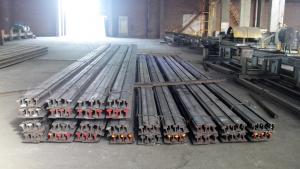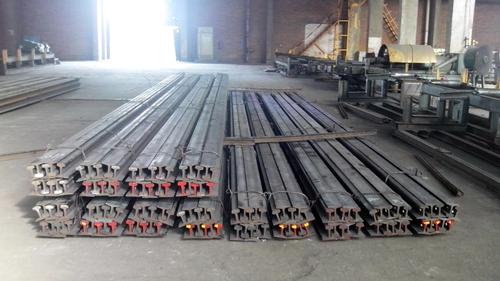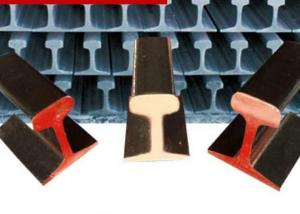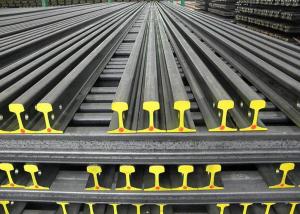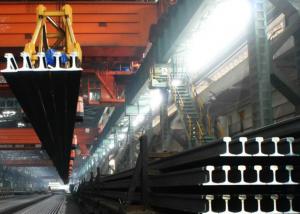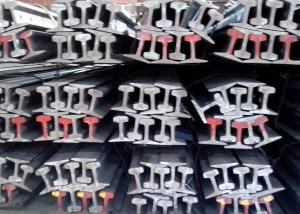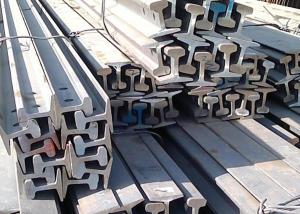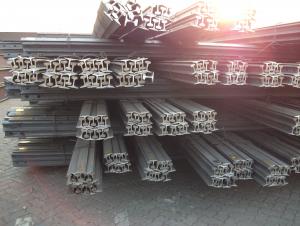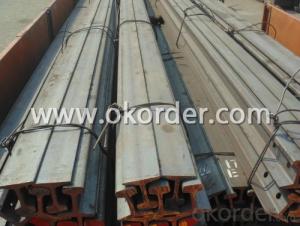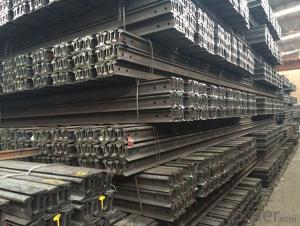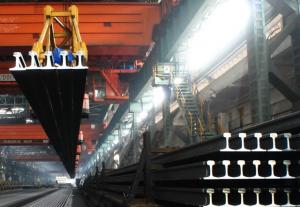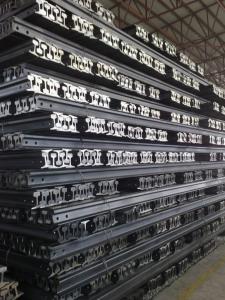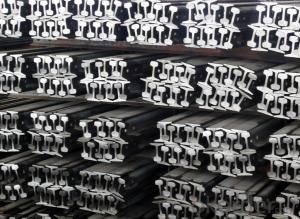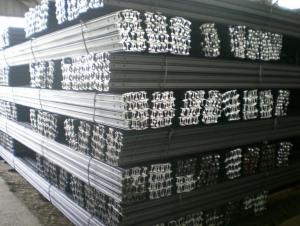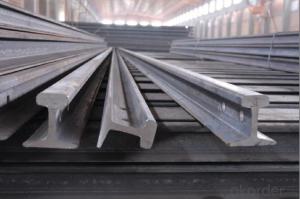MS Steel Rail GB Standard with High Quality for Sale
- Loading Port:
- China main port
- Payment Terms:
- TT or LC
- Min Order Qty:
- 25 m.t.
- Supply Capability:
- 100000 m.t./month
OKorder Service Pledge
OKorder Financial Service
You Might Also Like
Product Description of MS Steel Rail GB Standard with High Quality for Sale:
Sizes: 38kg, 43kg, 45kg, 50kg, 60kg.
Production Standard: GB2585-81, DIN, AREMA, JIS, BS, UIC, etc.
Material: 50MN, U71MN, 900A, 110A, etc.
Length: 6m-25m according to the requriements of the clients
Usages of MS Steel Rail GB Standard with High Quality for Sale:
Light rail is mainly used in forest region, mines, factories and construction sites laid of the place such as temporary transport line and light motorcycles with line. Be widely used for railway, subway, transportation track, express, curve way, tunnel way and so on.
Packaging & Delivery of MS Steel Rail GB Standard with High Quality for Sale:
1. Packing: it is nude packed in bundles by steel wire rod
2. Bundle weight: not more than 3.5MT for bulk vessel; less than 3 MT for container load
3. Marks:
Color marking: There will be color marking on both end of the bundle for the cargo delivered by bulk vessel. That makes it easily to distinguish at the destination port.
Tag mark: there will be tag mark tied up on the bundles. The information usually including supplier logo and name, product name, made in China, shipping marks and other information request by the customer.
If loading by container the marking is not needed, but we will prepare it as customer request.
4. Transportation: the goods are delivered by truck from mill to loading port, the maximum quantity can be loaded is around 40MTs by each truck. If the order quantity cannot reach the full truck loaded, the transportation cost per ton will be little higher than full load.
5. Delivered by container or bulk vessel
6. Delivery Time: All the Hot Rolled Steel Rail will be transpoted at the port of Tianjin, China within 30 days after receiving the advance payment by T/T or the orginal L/C at sight.
Inspection of MS Steel Rail GB Standard with High Quality for Sale:
We will send the MTC of the factory to the clients dirrectly which contain the anlisis of the heat, chemiqul composition, phisical characteristicas, etc.
And our inspectors will arrive at the factory to meke the inspection of the size, length, weight and quantity before the transportation from the factory.
FAQ:
Q1: Why buy Materials & Equipment from OKorder.com?
A1: All products offered by OKorder.com are carefully selected from China's most reliable manufacturing enterprises. Through its ISO certifications, OKorder.com adheres to the highest standards and a commitment to supply chain safety and customer satisfaction.
Q2: What makes stainless steel stainless?
A2: Stainless steel must contain at least 10.5 % chromium. It is this element that reacts with the oxygen in the air to form a complex chrome-oxide surface layer that is invisible but strong enough to prevent further oxygen from "staining" (rusting) the surface. Higher levels of chromium and the addition of other alloying elements such as nickel and molybdenum enhance this surface layer and improve the corrosion resistance of the stainless material.
Q3: Can stainless steel rust?
A3: Stainless does not "rust" as you think of regular steel rusting with a red oxide on the surface that flakes off. If you see red rust it is probably due to some iron particles that have contaminated the surface of the stainless steel and it is these iron particles that are rusting. Look at the source of the rusting and see if you can remove it from the surface.
Images:
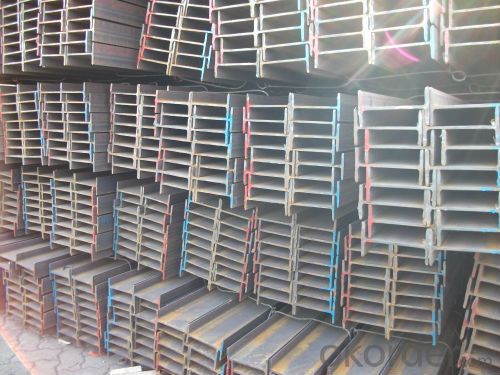
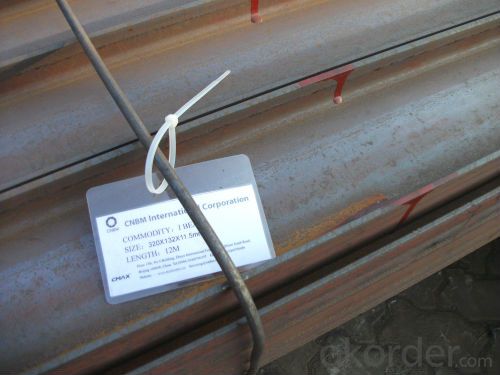
- Q: Are steel rails affected by extreme temperatures?
- Yes, steel rails can be affected by extreme temperatures. In extreme heat, steel expands, leading to potential buckling or warping of the rails. Conversely, in extreme cold, steel contracts, potentially causing the rails to crack or become brittle. Temperature fluctuations can also affect the stability and alignment of the tracks, requiring regular maintenance and monitoring.
- Q: What types of fasteners are used with steel rails?
- The types of fasteners commonly used with steel rails include rail clips, bolts, spikes, and fishplates.
- Q: Are steel rails used in urban transportation systems?
- Yes, steel rails are commonly used in urban transportation systems, such as subways, trams, and light rail systems, due to their durability, strength, and ability to withstand heavy loads and frequent use.
- Q: What are the dimensions of a standard steel rail?
- The dimensions of a standard steel rail typically vary depending on the specific application and country. However, in many countries, a standard steel rail for railway tracks is commonly around 30 feet long, 6 inches high, and 3 inches wide.
- Q: What are the different methods of monitoring steel rail integrity?
- There are several methods for monitoring steel rail integrity, including visual inspection, ultrasonic testing, magnetic flux leakage testing, and eddy current testing. Visual inspection involves physically inspecting the rail for any visible signs of damage or wear. Ultrasonic testing uses high-frequency sound waves to detect internal defects in the rail. Magnetic flux leakage testing uses magnets and sensors to detect any magnetic anomalies caused by defects in the rail. Eddy current testing involves passing an electrical current through the rail and measuring any changes in the magnetic field to detect surface defects. These methods help ensure the safety and reliability of steel rails in various applications.
- Q: How are the ends of steel rails connected?
- The ends of steel rails are typically connected using a method called rail welding. Rail welding involves heating the ends of two steel rails to a high temperature using a gas-powered torch. Once the ends are heated, they are brought together and pressed firmly against each other to form a solid bond. This process is known as thermite welding or aluminothermic welding. The high temperature causes a chemical reaction between the steel and a mixture of aluminum powder and iron oxide, which results in the formation of molten steel. The molten steel fills the gaps between the rail ends, creating a strong and seamless connection. After the welding process is complete, the joint is typically ground and polished to ensure a smooth and continuous rail track. Rail welding is a widely used method for connecting steel rails as it provides a durable and secure connection that can withstand the immense forces and stresses exerted on the rails by trains.
- Q: Do steel rails require regular inspections?
- Indeed, regular inspections are essential for steel rails. They play a crucial role in guaranteeing the safety and soundness of railway tracks. These inspections serve the purpose of identifying any potential problems that may arise, such as cracks, wear, or damage in the steel rails. Trained personnel can carry out visual inspections, or advanced technologies like ultrasonic testing or track geometry measurement systems can be employed. Through these routine inspections, railway authorities can take proactive measures to address any issues promptly, performing necessary maintenance or repairs in order to prevent accidents or derailments. Moreover, regular inspections contribute to prolonging the lifespan of steel rails and ensuring the smooth and efficient functioning of train operations.
- Q: How are steel rails maintained in remote areas?
- Steel rails in remote areas are typically maintained through regular inspections and preventive maintenance programs. These programs involve routine checks for any signs of wear, damage, or defects on the rails and their supporting structures. In addition, specialized maintenance vehicles equipped with rail grinding machines are often used to smooth out any rough spots or irregularities on the rails, ensuring safe and efficient train operations. Remote areas may also utilize advanced monitoring technologies, such as track geometry cars and drones, to assess the condition of the rails and promptly address any issues that arise.
- Q: What are the safety precautions when working with steel rails?
- When working with steel rails, it is important to follow several safety precautions. Firstly, ensure that you are wearing the appropriate personal protective equipment, such as steel-toed boots, gloves, and safety glasses. Secondly, be aware of your surroundings and avoid standing or walking on the rails to prevent tripping or falling. Always use proper lifting techniques when handling steel rails to prevent back or muscle injuries. Additionally, never place your hands or fingers between the rails while moving or aligning them to avoid crushing injuries. Lastly, communicate effectively with others working in the area and use caution signs or barriers to warn others of potential hazards.
- Q: How do steel rails contribute to train ride comfort?
- The comfort of train rides is enhanced by the presence of steel rails in several ways. Firstly, the smooth and stable surface provided by these rails allows the train wheels to roll without any abrupt changes or irregularities in the track, thereby minimizing jolts or vibrations that passengers may feel. This smoothness significantly improves the comfort of the train ride and reduces the likelihood of discomfort or motion sickness. Moreover, steel rails are designed to evenly distribute the weight of the train, thereby spreading the load across a larger surface area. This distribution of weight helps to reduce the impact and pressure exerted on the wheels and the entire train, ultimately resulting in a more stable and comfortable ride with minimal vertical or lateral movements. In addition, the durability of steel rails is noteworthy, as they are built to withstand heavy loads, extreme weather conditions, and constant use. This durability ensures that the rails maintain their shape and alignment, preventing any deformations or unevenness that could cause discomfort during the train ride. Furthermore, the engineering of steel rails focuses on minimizing noise and vibration. The smooth surface and precise alignment of the rails reduce friction between the wheels and the track, leading to lower noise levels. Additionally, the weight distribution and stability provided by the rails help to minimize vibrations, resulting in a quieter and more pleasant train ride for passengers. In conclusion, the presence of steel rails greatly contributes to the comfort of train rides by offering a smooth and stable surface, evenly distributing weight, maintaining durability, and reducing noise and vibrations. These factors work together to ensure a comfortable and enjoyable journey for passengers.
Send your message to us
MS Steel Rail GB Standard with High Quality for Sale
- Loading Port:
- China main port
- Payment Terms:
- TT or LC
- Min Order Qty:
- 25 m.t.
- Supply Capability:
- 100000 m.t./month
OKorder Service Pledge
OKorder Financial Service
Similar products
Hot products
Hot Searches
